Asus ET2040 IUK comes with large screen, sleek design and has power backup. Coupled with decent specification and affordable pricing, this seems to be a good All in One. I received the review unit last week and I am using the Asus All in One as my primary PC till then. Based on my experience, here is my Asus ET 2040 IUK Review.
The Asus ET2040 is powered by 2.5 GHz Pentium J2900 quad core processor with 2GB of RAM and the 500GB hard disk. My review unit came with 4GB of RAM where as the retail unit which is available in India has only 2GB of RAM. The processor is not the fastest but it is suffice for the most basic day to day activities. The normal Word processing, Excel sheets and Power point presentations worked well. Even I played 1080p HD sample video, which played without any issues.
The Asus ET2040IUK All in One Desktop sports 19.5 inch display screen with a screen resolution of 1366×768 pixel. The brightness and colors look good on the screen. Even the viewing angles are decent enough but not great. There is a hands free gesture control which covers few of the drawbacks of not having touch screen. It does its job but I felt it could have been better.
Another main aspect of Asus ET 2040 All in One is its power back up. In my usage, I got around one to one and half hours of battery backup on my regular usage when connected to WiFi. Other features of this Asus All in One includes three usb 3.0 ports, three USB 2.0 ports, HDMI output and card reader. There is also inbuilt speaker. The quality of sound output of the built in speaker is not great.
Read: Asus EeeBook Review.
Asus ET 2040 All in One Speed Optimisation Tip
If you are feeling your Asus All in One is slow, then uninstall the McAfee. It will boost your All in One performance by very much. The built in Windows Defender does the work done.
Advantages and Disadvantages of Asus ET2040 All In One
Pros of Asus ET2040
- Power Backup: Asus ET2040 has a good power backup considering the size of the screen.
- Simple and Portable: It is very easy to transport or move within your house. It saves place as it requires very less space compared to regular desktops.
- Good Display screen: The display screen is decent enough to watch videos or browsing the net.
- Connectivity Options: Asus has done a good job by providing 3 USB 3.0 ports, 3 USB 2.0 ports and a HDMI ports.
Cons of Asus ET2040
- Non Touch screen: Though there is a gesture control support, it would have been great if would have come with touch screen.
- No RAM upgradation option: Having only 2GB of RAM might limit multi tasking of this device. However, the review unit with 4GB RAM does multi tasking decently. I have tried opening simultaneously 1080p video, Chrome Browser with multiple tabs and a word processor. I have not felt any lagging or slowness. So it would have been great of the Asus All in One comes with 4GB RAM out of the box.
- Sound Volume and clarity: The sound volume of inbuilt is not high enough. Even clarity of sound not great.
- Trial version of McAfee Anti virus: The Asus All in One comes with trial version of McAfee anti virus. Considering the specs, it would been great if this does not comes with McAfee out of the box as McAfee slows the All in One significantly. However, you have the option to uninstall the McAfee Anti virus programme.
Asus ET2040IUK All in One Specification
- Processor: 2.5GHz Pentium J2900 quad-core
- RAM: 2GB
- Display: 19.5” 1366x768p
- Internal storage: 500GB
- 1MP Camera, Built in Speaker
- Power Backup
- Windows 8.1
- Ports: 3 USB 3.0 ports, 3 USB 2.0 ports, HDMI, LAN port.




